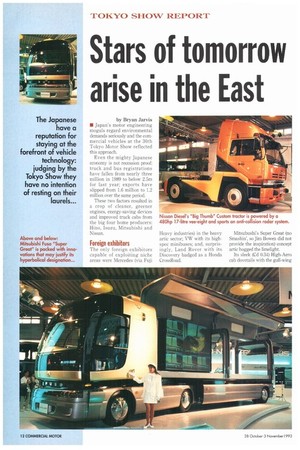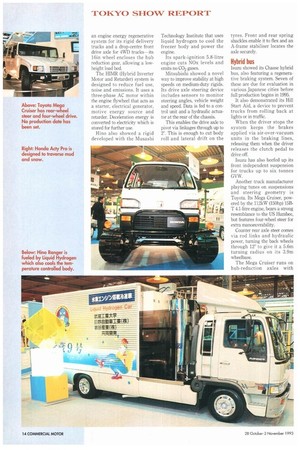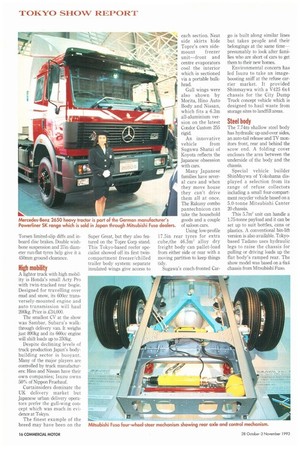Stars of tomorrow arise in the East
Page 14

Page 15

Page 16

Page 18

If you've noticed an error in this article please click here to report it so we can fix it.
by Bryan Jarvis • Japan's motor engineering moguls regard environmental demands seriously and the com• mercial vehicles at the 30th Tokyo Motor Show reflected this approach.
Even the mighty Japanese economy is not recession proof: truck and bus registrations have fallen from nearly three million in 1989 to below 2.5m for last year; exports have slipped from 1.6 million to 1.2 million over the same period.
These two factors resulted in a crop of cleaner, greener engines, energy-saving devices and improved truck cabs from the big four home producers: Hino, lsuzu, Mitsubishi and Nissan.
Foreign exhibitors
The only foreign exhibitors capable of exploiting niche areas were Mercedes (via Fuji
Heavy industries) in the heavy artic sector; VW with its highspec minibuses; and, surprisingly, Land Rover with its Discovery badged as a Honda CrossRoad. Mitsubushi's Super Great (no Smashin', so Jim Bowen did not provide the inspiration) concept artic hogged the limelight.
Its sleek (Cd 0.34) High-Aero cab dovetails with the gull-wing bodied trailer and features full air-wedge braking, hydraulically modulated suspension and a 300kW (400hp) 20-litre 8M20 naturally-aspirated diesel which is ready for Japan's 1994 emissions requirements.
The superbly finished FRP trailer had moulded skirts and a tailgate. Each section raises hydraulically using remote controls; an audio-visual -in-cab warning system reminds the driver not to move off with the sides extended.
Remote controlled swingback doors and an elevating step take the driver up to the futuristic cabin with its T-bone dash panel which has everything but the kitchen sink and full cross-cab freedom. As you'd expect from the Japanese, the hitech aspects of this concept vehicle are about as high as they come.
The panoramic windscreen has an outer water repellent fluoro-plastic skin with a transparent conductive polymer matrix/liquid crystal inside. At the flick of a switch the driver can cut dazzle by changing the type of light that the screen will admit..
Cameras on all sides of the vehicle feed data into the instrument panel which converts it into analogue speedo and tacho displays above town speeds. A head-up display passes information to the driver, including a laser-radar distance warning to avoid tail-gating.
The Japanese have even addressed the problem of driver fatigue. The Super Great has a "white-line tracker" that monitors directional stability. If the truck begins to wander, implying that the driver is losing concentration, the system pumps oxygen into the cab, activates an audible warning,and switches on a vibrator in the seat. Try dozing through that lot!
Less radical, but equally useful, are the automatic lift-up air/electric coupling suzies.
The Super Great may well be the shape of things to come but most of the launches at Tokyo will be coming on to the road rather more quickly.
New cabs
New cabs included Nissan's Big Thumb range and Hino's Super Dolphin, several of which are already being prepared for shipment to Harris in Ireland, In line with a trend towards improving the Japanese driver's environment, Hino offers Eaton's Twin Splitter or SAMT: 30 have been supplied to date.
Mitsubishi was not the only manufacturer to offer radar. Nissan has its own anti-collision warning system in the Big Thumb cab, as well as an electronically controlled transmission called ESCOT (Easy Safe Controlled Transmission) that the driver uses a la Mercedes EPS with no need to worry about the clutch. Extra glass is fitted in the high roof, sides and passenger door; power comes from a 358kW (480hp) vee eight.
Neat controls include a lever to adjust the nearside mirrors or pull both side arms into the cab to avoid damage when squeezing though narrow lanes.
Other exhibits from Hino included a new clean-running 17-litre RF8TA 355kW (476hp) diesel, an accumulator-type hybrid energy recovery system for vehicles on frequent stop/go work, and a prototype gas-powered 4x2 delivery truck called the Condor.
This has a 7.0-litre engine running on compressed natural gas fed from the eight 360-litre cylinders strapped to the chassis. It gives off no black smoke or sulphur oxide (S0x); nitrogen oxide (N0x) levels are said to be low. Buses with CNG engines are undergoing trials now.
Great claims are made for the fuel efficiency of Hino latest P11C charge-cooled 10.5-litre diesel which runs at a lean185g/kW.h. Its next generation is said to be even cleaner and leaner, thanks to electronically controlled high-pressure centre injection, four valve heads and a new variable diffuser type turbo from either Zexel or Nippondenso. It will also have ceramic-faced cast iron pistons with ceramic roller big end and mains bearings.
Partial exhaust gas recirculation and a catalytic converter will also be included.
The Hino design team are obviously fully aware of the ceaseless demand for more power. Super Dolphin Profia cab, now fitted with air suspension,sits over its Fl7D 16-litre vee-eight which pumps out 382kW (520hp). For the first time Japanese operators will be able to channel that power through Eaton's SAMT; the gear indicator is in the middle of the dash.
Other Hino goodies included an engine energy regenerative system for its rigid delivery trucks and a drop-centre front drive axle for 4WD trucks—its 16in wheel encloses the hub reduction gear, allowing a lowheight load bed.
The HIMR (Hybrid Inverter Motor and Retarder) system is designed to reduce fuel use, noise and emissions. It uses a three-phase AC motor within the engine flywheel that acts as a starter, electrical generator, motive energy source and retarder. Deceleration energy is converted to electricity which is stored for further use.
Hino also showed a rigid developed with the Musashi Technology Institute that uses liquid hydrogen to cool the freezer body and power the engine.
Its spark-ignition 5.8-litre engine cuts NOx levels and emits no CO2 gases.
Mitsubishi showed a novel way to improve stability at high speeds on medium-duty rigids. Its drive axle steering device includes sensors to monitor steering angles, vehicle weight and speed. Data is fed to a control unit and a hydraulic actuator at the rear of the chassis.
This enables the drive axle to pivot via linkages through up to 2°. This is enough to cut body roll and lateral drift on the
tyres. Front and rear spring shackles enable it to flex and an A-frame stabiliser locates the axle securely.
Hybrid bus Isuzu showed its Chasse hybrid bus, also featuring a regenerative braking system. Seven of these are due for evaluation in various Japanese cities before full production begins in 1995.
It also demonstrated its Hill Start Aid, a device to prevent trucks from rolling back at lights or in traffic.
When the driver stops the system keeps the brakes applied via air-over-vacuum units in the braking lines, releasing them when the driver releases the clutch pedal to drive off.
Isuzu has also beefed up its front independent suspension for trucks up to six tonnes GVW.
Another truck manufacturer playing tunes on suspensions and steering geometry is Toyota. Its Mega Cruiser, powered by the 112kW (150hp) 15BT 4.1-litre engine, bears a strong resemblance to the US Hurnbee, but features four-wheel steer for extra manoeuvrability.
Counter rear axle steer comes via rod links and hydraulic power, turning the back wheels through 12° to give it a 5.6m turning radius on its 3.9m wheelbase.
The Mega Cruiser runs on hub-reduction axles with Torsen limited-slip diffs and inboard disc brakes. Double wishbone suspension and 37in diameter run-flat tyres help give it a 450mm ground clearance.
High mobility
A lighter truck with high mobility is Honda's small Acty Pro with twin-tracked rear bogie. Designed for travelling over mud and snow, its 600cc transversely-mounted engine and auto transmission will haul 200kg. Price is £34,000.
The smallest CV at the show was Sambar, Subaru's walkthrough delivery van It weighs just 890kg and its 660cc engine will shift loads up to 350kg.
Despite declining levels of truck production Japan's bodybuilding sector is buoyant. Many of the major players are controlled by truck manufacturers: Hino and Nissan have their own companies; Isuzu owns 50% of Nippon Fruehauf.
Curtainsiders dominate the UK delivery market but Japanese urban delivery operators prefer the gull-wing concept which was much in evidence at Tokyo.
The finest example of the breed may have been on the Super Great, but they also featured on the Topre Corp stand. This Tokyo-based reefer specialist showed off its first twincompartment freezer/chilled trailer body system: separate insulated wings give access to each section. Neat side skirts hide Topre's own side mount freezer unit—front and centre evaporators cool the interior which is sectioned via a portable bulkhead.
Gull wings were also shown by Morita, Hino Auto Body and Nissan, which fits a 6.3m all-aluminium version on the latest Condor Custom 255 rigid.
An innovative vehicle from Sugawa Shatai of Koyota reflects the Japanese obsession with cars.
Many Japanese families have several cars and when they move house they can't drive them all at once. The Rakuny combo pantechnicon can take the household goods and a couple of saloon cars.
Using low-profile 17.5in rear tyres for extra cube,the 46.5m3 alloy dry freight body can pallet-load from either side or rear with a moving partition to keep things tidy.
Sugawa's coach-fronted Car
go is built along similar lines but takes people and their belongings at the same time— presumably to look after families who are short of cars to get them to their new homes.
Environmental concern has led Isuzu to take an imageboosting sniff at the refuse carrier market. It provided Shinmaywa with a V425 6x4 chassis for the City Dump Truck concept vehicle which is designed to haul waste from storage sites to landfill areas.
Steel body
The 7.74m shallow steel body has hydraulic up-and-over sides, an auto-tail release and TV monitors front, rear and behind the scow end. A folding cover encloses the area between the underside of the body and the chassis.
Special vehicle builder ShinMaywa of Yokohama displayed a selection from its range of refuse collectors including a small four-compartment recycler vehicle based on a 5.0-tonne Mitsubishi Canter 20 chassis.
This 5.7m3 unit can handle a 175-tonne payload and it can be set up to suit bottles, cans or plastics. A conventional bin-lift version is also available. Tokyobased Tadano uses hydraulic legs to raise the chassis for pulling or driving loads up the flat body's ramped rear. The show model was based on a 6x4 chassis from Mitsubishi Fuso.
































































































